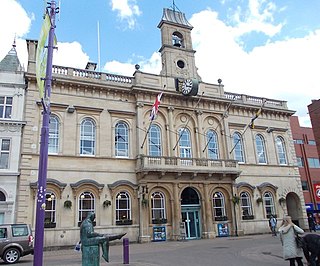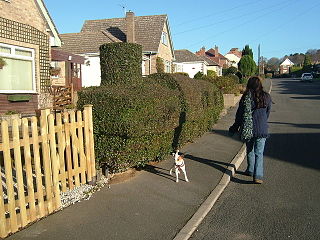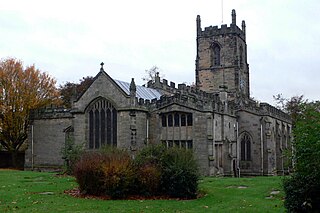
Ashby de la Zouch, sometimes hyphenated as Ashby-de-la-Zouch, and shortened locally to Ashby, is a market town and civil parish in the North West Leicestershire district of Leicestershire, England. The town is near to the Derbyshire and Staffordshire borders. Its 2001 census population of 11,410 rose to 12,370 in 2011. The castle in the town was an important fort in the 15th–17th centuries. In the 19th century the town's main industries were ribbon manufacture, coal mining, and brickmaking.

Ashby de la Zouch Castle is a ruined fortification in the town of Ashby-de-la-Zouch, Leicestershire, England. The castle was built by William, Lord Hastings, a favourite of Edward IV, after 1473, accompanied by the creation of a 3,000-acre (1,200 ha) park. Constructed on the site of an older manor house, two large towers and various smaller buildings had been constructed by 1483, when Hastings was executed by Richard, Duke of Gloucester. The Hastings family used the castle as their seat for several generations, improving the gardens and hosting royal visitors.

Donisthorpe is a village in the North West Leicestershire district of Leicestershire, England, historically an exclave of Derbyshire.

North West Leicestershire is a local government district in Leicestershire, England. The population of the Local Authority at the 2011 census was 93,348. Its main towns are Ashby-de-la-Zouch, Castle Donington, Coalville and Ibstock.

The Loughborough Town Hall is a building fronting onto the Market Place in Loughborough, Leicestershire, England. Built as a corn exchange and ballroom in 1855, it became a municipal building and subsequently a theatre. It is a Grade II listed building.

Blackfordby is a small village and former civil parish, now in the parish of Ashby-de-la-Zouch, in the North West Leicestershire district, in the northwesternmost corner of Leicestershire, England. It is about 2 miles (3.2 km) to the northwest of Ashby-de-la-Zouch and 2 miles southeast of Swadlincote. In 1931 the parish had a population of 705. On some early maps, such as one dated 1587, the village is shown as "Blaugherby", hence the local name of "Blofferby". The village is dominated by the Church of St Margaret of Antioch, Blackfordby, erected in 1858 on the site of an earlier Anglican Chapel which was attached to the St Helen's Church, Ashby-de-la-Zouch. The church stands in an elevated position next to the village school, and is built in the early English style. The church has a nave and chancel, with a tower surmounted by a broach spire and, for the greater part of the work, constructed from local sandstone which has become blackened due to the effects of air pollution.
Henry Isaac Stevens FRIBA was an architect based in Derby. He was born in London, in 1806, and died in 1873. In the late 1850s he changed his name to Isaac Henry Stevens.

St Helen's Church is the Anglican parish church of Ashby-de-la-Zouch, in the deanery of North West Leicestershire and the Diocese of Leicester. There was a church in the town in the 11th century, but the core of the present building mainly dates from work started in 1474, when the church was rebuilt by William Hastings at the same time that he converted his neighbouring manor house into a castle. The church was refurbished in about 1670 to create more space, but the large and increasing size of the congregation led to further work in 1829, and a major rebuild in 1878–80, including the widening of the nave by the addition of two outer aisles.

Warminster Town Hall is a former municipal building in the Market Place of Warminster, Wiltshire, England. The structure, which served as the headquarters of Warminster Urban District Council, is a Grade II listed building.

Romsey Town Hall is a municipal building in the Market Place in Romsey, Hampshire, England. The structure is the meeting place of Romsey Town Council.

The Queen's Hall, formerly Hexham Town Hall, is a municipal structure in Beaumont Street, Hexham, Northumberland, England. The structure, which was the headquarters of Hexham Urban District Council and is now an arts centre, is a Grade II listed building.

Chudleigh Town Hall is a municipal building in Market Way, Chudleigh, Devon, England. The town hall, which is the meeting place of Chudleigh Town Council, is a Grade II listed building.

Seaton Town Hall is a municipal building in Fore Street, Seaton, Devon, England. The town hall, which was the meeting place of Seaton Urban District Council, is now used as a theatre.

Hedon Town Hall is a municipal building in St Augustine's Gate, Hedon, East Riding of Yorkshire, England. The building, which is the meeting place of Hedon Town Council, is a Grade II* listed building.

Garstang Town Hall is a municipal building in the High Street in Garstang, Lancashire, England. The structure, which currently accommodates two shops and a Royal British Legion Club, is a Grade II listed building.

The Old Town Hall is a municipal building in the Market Place in Faringdon, Oxfordshire, England. The building, which is used as an exhibitions and events venue, is a Grade II* listed building.

Crewkerne Town Hall is a municipal building in the Market Square in Crewkerne, Somerset, England. The building, which is the meeting place of Crewkerne Town Council, is a Grade II listed building.

The Town House is a municipal building in Union Street in Yeovil, Somerset, England. The building, which is the meeting place of Yeovil Town Council, is a Grade II listed building.

Bala Town Hall, known in the late 19th century as the County Hall, is a municipal building in Bala, Gwynedd, Wales. The structure, which is now used as a restaurant, is a Grade II listed building.

Crickhowell Market Hall, formerly Crickhowell Town Hall, is a municipal building in the High Street, Crickhowell, Powys, Wales. The structure, which accommodates market stalls on the ground floor and a café on the first floor, is a Grade II* listed building.




















